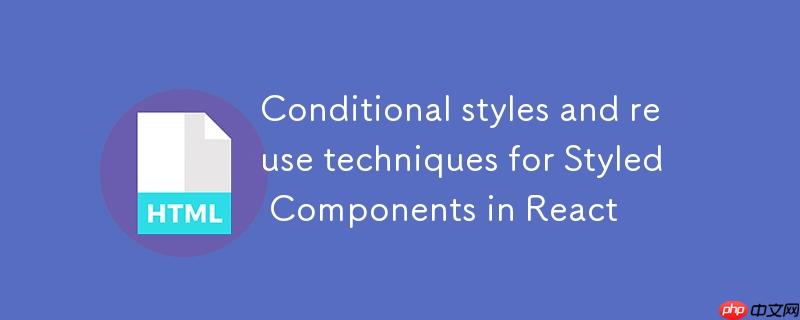
在react应用中,styled-components提供了一种将css直接绑定到组件的强大方式,它消除了传统css类名管理的复杂性。然而,初学者在使用过程中常会遇到如何实现条件样式和样式复用的挑战。本教程将详细介绍这两种核心场景的解决方案。
在传统React开发中,我们可能通过条件判断来动态切换CSS类名,例如 <div className={color ? 'header header-bg' : 'header'}>。在styled-components中,这种模式被更优雅地替换为通过组件的props来传递条件,并在样式定义内部进行判断。
核心思想:styled-components允许你在其模板字符串中访问组件的props。你可以传入一个函数,该函数会接收组件的所有props作为参数,并返回相应的CSS值。
示例代码:
假设我们有一个Header组件,需要根据isActive prop来改变背景颜色。
import styled from 'styled-components';
// 定义一个Styled Header组件
const Header = styled.div`
padding: 10px 20px;
font-size: 18px;
color: white;
text-align: center;
/* 根据isActive prop动态设置背景颜色 */
background-color: ${props => (props.isActive ? '#007bff' : '#6c757d')};
border-radius: 5px;
margin-bottom: 10px;
/* 也可以根据多个props进行更复杂的判断 */
border: ${props => (props.hasBorder ? '1px solid #dee2e6' : 'none')};
`;
// 在React组件中使用
function App() {
const [active, setActive] = React.useState(false);
return (
<div>
<Header isActive={active} hasBorder={true}>
这是一个动态Header
</Header>
<Header isActive={!active}>
这是另一个Header
</Header>
<button onClick={() => setActive(!active)}>
切换Header状态
</button>
</div>
);
}
export default App;解析: 在Header组件的样式定义中,我们使用了 ${props => ...} 这种函数形式。当Header组件被渲染时,这个函数会被执行,并接收当前组件的所有props。通过访问 props.isActive,我们就能根据其布尔值来决定使用蓝色 (#007bff) 还是灰色 (#6c757d) 作为背景色。
注意事项:
在传统CSS中,我们经常会看到 .class1, .class2, .class3 { styles } 这样的写法,将相同的样式应用于多个选择器。在styled-components中,如果多个组件需要共享一套相同的CSS规则,直接为每个组件重复编写这些规则会导致代码冗余。styled-components提供了css辅助函数来解决这个问题。
核心思想:styled-components导出的css辅助函数允许你创建可复用的CSS代码块。这些代码块可以在多个styled-components定义中被引用,从而避免重复。
示例代码:
假设我们有三个按钮组件,它们都需要共享一些基础的样式,如padding、border-radius和cursor。
import styled, { css } from 'styled-components';
// 1. 定义一个可复用的CSS代码块
const ButtonBaseStyles = css`
padding: 10px 15px;
border-radius: 5px;
cursor: pointer;
font-size: 16px;
transition: background-color 0.3s ease;
border: none;
&:hover {
opacity: 0.9;
}
`;
// 2. 为每个组件应用基础样式,并添加各自特有的样式
const PrimaryButton = styled.button`
${ButtonBaseStyles} /* 引用共享样式 */
background-color: #007bff;
color: white;
&:active {
background-color: #0056b3;
}
`;
const SecondaryButton = styled.button`
${ButtonBaseStyles} /* 引用共享样式 */
background-color: #6c757d;
color: white;
&:active {
background-color: #545b62;
}
`;
const OutlineButton = styled.button`
${ButtonBaseStyles} /* 引用共享样式 */
background-color: transparent;
color: #007bff;
border: 1px solid #007bff;
&:hover {
background-color: #e0f0ff;
}
&:active {
background-color: #cce0ff;
}
`;
// 在React组件中使用
function App() {
return (
<div>
<PrimaryButton>主要按钮</PrimaryButton>
<SecondaryButton>次要按钮</SecondaryButton>
<OutlineButton>边框按钮</OutlineButton>
</div>
);
}
export default App;解析: 我们首先使用css辅助函数创建了一个名为ButtonBaseStyles的模板字面量。这个模板字面量包含了所有按钮组件共有的样式规则。然后,在定义PrimaryButton、SecondaryButton和OutlineButton时,我们通过 ${ButtonBaseStyles} 的形式将其注入到各自的样式定义中。这样,每个按钮组件都能获得基础样式,同时可以添加或覆盖特有的样式,极大地减少了代码重复。
注意事项:
styled-components通过props驱动的条件样式和css辅助函数提供的样式复用能力,极大地提升了React应用中样式管理的灵活性和效率。掌握这些技巧不仅能帮助你编写出更简洁、更易维护的样式代码,还能让你更好地利用CSS-in-JS的强大功能。建议进一步查阅styled-components的官方文档,探索更多高级用法,如主题化(ThemeProvider)、动画和动态组件等,以构建更强大的用户界面。
以上就是React中Styled Components的条件样式与复用技巧的详细内容,更多请关注php中文网其它相关文章!

每个人都需要一台速度更快、更稳定的 PC。随着时间的推移,垃圾文件、旧注册表数据和不必要的后台进程会占用资源并降低性能。幸运的是,许多工具可以让 Windows 保持平稳运行。

Copyright 2014-2025 https://www.php.cn/ All Rights Reserved | php.cn | 湘ICP备2023035733号